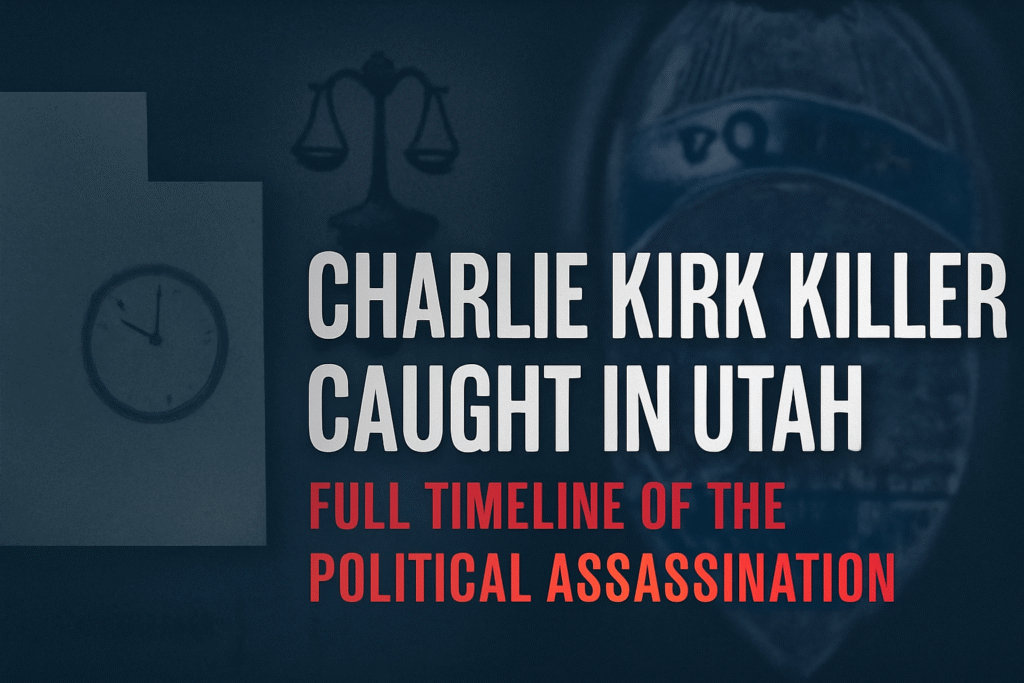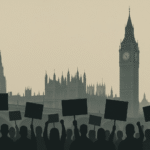
The alleged killer of conservative activist Charlie Kirk was taken into custody in Utah after a two-day manhunt, and below is a verified, minute-by-minute timeline of the shooting, investigation, arrest, and the misinformation that followed, drawn from multiple credible live updates and reports.
This long-form explainer reconstructs the events at Utah Valley University, how the suspect was identified and apprehended, what investigators recovered, how officials reacted, and what comes next in the case.
Overview
Authorities say a 22-year-old Utah man was arrested on suspicion of killing Charlie Kirk following a multi-agency manhunt that began after the fatal shooting at Utah Valley University in Orem.
Investigators cited family tips, surveillance review, and clothing and vehicle matches as key steps that led to the suspect’s arrest and booking in Utah County, with federal and state agencies coordinating throughout.
What happened at UVU:
Charlie Kirk was shot during a daytime appearance at Utah Valley University, where he had been addressing a large crowd as part of a campus stop; law enforcement and campus authorities reported a single gunshot that triggered a rapid evacuation.
Video from the event captured the moment of the shot and ensuing panic, and officials swiftly launched a university-wide response while clarifying that two early detainees were not suspects and were released.
Day 1: The shooting and initial manhunt (Sept 10)
Following the shooting, Utah authorities initiated an intensive manhunt, coordinating with federal partners, and urged the public to come forward with any relevant information about the attacker.
As the night progressed, the search continued with expanded investigative steps and appeals for tips while officials shared the first still images and preliminary details to crowdsource leads.
Day 2: Person of interest images and surge of misinformation (Sept 11)
Investigators released images of a person of interest and emphasized the urgency of the public’s cooperation, while social media rapidly filled with conspiracies, recycled videos, and false identifications that complicated the information environment.
Reuters documented fake headlines, misattributed clips from unrelated incidents, and a wave of baseless claims that authorities had to counter in real time to keep the focus on verified leads.
Day 3: Arrest in Utah (Sept 12)
By early September 12, officials announced that a 22-year-old suspect, identified as Tyler Robinson, was in custody after being booked into the Utah County Jail, concluding a two-day manhunt.
Utah’s governor and federal authorities said a family member’s tip and surveillance analysis—down to clothing and vehicle details—were pivotal in pinpointing the suspect and making the arrest.
How the suspect was identified
Authorities reviewed surveillance imagery that reportedly showed the suspect arriving at campus in a gray Dodge Challenger and wearing a maroon shirt, light shorts, a black cap with a white logo, and light shoes.
Officials said a relative tipped law enforcement after the suspect allegedly conveyed involvement and had previously voiced political animus toward Kirk, a detail recounted in subsequent briefings and reports.
What investigators recovered a bolt-action rifle believed to have been used in the attack, along with ammunition, and traced ballistic evidence from the scene and nearby wooded areas.
Additional reporting noted inscriptions on recovered casings and a rooftop firing position, with an FBI-released video showing the shooter fleeing by leaping from a building and running off campus.
The rooftop vantage point
Officials said forensic and trace evidence on a rooftop—including prints and impressions—helped map the shooter’s pathway to and from the firing position.
The FBI video depicted the suspect’s quick descent and escape route, which investigators connected with subsequent evidence recovery in the surrounding area.
Arrest details and custody.
Live updates indicated the suspect was apprehended and booked in the early hours of September 12 in Utah County, drawing a direct line from public tips to localized investigative follow-up.
Authorities credited interagency coordination for the speed of the arrest, and news outlets reported that charging decisions would follow as evidence review proceeded.
Working theory vs. confirmed motive:
Officials have publicly detailed the investigative sequence and evidence but have not announced a formal motive; family statements referenced by media describe a recent political radicalization and animus toward Kirk.
Authorities continue to gather and test evidence, and any definitive motive attribution is expected to be established through formal filings and court proceedings rather than preliminary statements.
Political and public reaction
Political leaders across the spectrum condemned the killing, with prominent figures describing it as a national tragedy and urging calm while the investigation unfolded.
The former president publicly mourned Kirk’s death, while other senior officials praised the pace of the investigation and lauded the public for tips that sped the arrest.
The “assassination” designation
Major newsrooms and public officials repeatedly described the killing as a political assassination, framing it within a broader context of heightened tensions and targeted violence.
Coverage emphasized that the combination of a rooftop firing position, a high-profile political figure, and the rapid federal response underscored the political and public-safety stakes of the case.
The misinformation surge
Large volumes of false claims circulated online within hours, including fabricated headlines, captioned video, and wrongly identified “suspects,” which newsrooms and fact-checkers debunked.
One Canadian retiree was falsely accused by impersonator accounts, illustrating how quickly innocent people can be swept up in viral speculation during breaking events.
Conspiracy claims about “hand signals”
Footage from the event spurred viral but unsubstantiated claims that gestures in the crowd were signals to the shooter, which investigators have not corroborated and which drew substantial pushback as reckless conjecture.
Authorities have focused on physical evidence recovery and trace analysis rather than crowdsourced theories, stressing verifiable leads over unproven online narratives.
Security questions for outdoor events.
Security professionals and reporting highlighted the challenge of securing open-air stages against elevated, standoff shooters and the constraints campus police face at large public gatherings.
The suspected rooftop firing angle and rapid escape underscore how attackers can exploit line-of-sight and perimeter gaps despite visible on-site security measures.
Law enforcement milestones (at a glance)
- UV shooting and immediate campus response with single-shot report and building evacuations.
- Person of interest images released and multi-agency manhunt escalated.
- Family tip after surveillance imagery review connects suspect to clothes and vehicle.
- Bolt-action rifle and ammunition recovered; FBI video shows rooftop escape.
- Arrest and booking in Utah County announced amid sustained federal coordination.
What charges are expected?
A court affidavit and live reporting referenced suspicion of aggravated murder and related firearm offenses, with formal charging documents expected as prosecutors finalize filings.
Officials emphasized that specific counts will be confirmed in court, with additional enhancements possible depending on evidence of premeditation and targeting.
What is next procedurally
The suspect is expected to make an initial appearance where a judge will address counsel, detention status, and scheduling, followed by discovery and potential grand jury action.
Investigators will continue forensic testing and digital mapping to strengthen the evidentiary chain while prosecutors evaluate aggregators and potential jurisdictional overlays.
Media coverage snapshot
Multiple outlets ran live blogs and timelines, offering minute-by-minute updates about the manhunt and arrest, often emphasizing public tips as decisive factors.
In-depth features have begun reconstructing Kirk’s final hours, the staging of the event, and the wider national climate in which the attack occurred.
Impact on campuses and public safety.
The killing triggered heightened alerts and, in some areas, a rise in hoax swatting calls, stretching campus safety resources and complicating emergency response.
Authorities urged the public to remain vigilant while avoiding the amplification of unverified claims that can both hinder investigations and traumatize communities.
Lessons for crisis information hygiene
Follow official channels, avoid sharing unverified “suspect” images, and consider that breaking news is fluid—credible outlets correct and update as new facts emerge.
When in doubt, cross-check multiple reputable live updates rather than relying on single-source screenshots or recycled clips from unrelated events.
Frequently asked questions
- Was the suspect caught in Utah?
Yes, officials announced that a 22-year-old suspect, identified as Tyler Robinson, was taken into custody and booked into the Utah County Jail following the two-day manhunt.
- How was the suspect identified so quickly?
A family member’s tip, which referenced the suspect’s statements and criticisms of Kirk, combined with surveillance imagery of clothing and a gray Dodge Challenger, helped investigators zero in rapidly.
- What evidence did investigators recover?
Authorities recovered a bolt-action rifle and ammunition linked to the scene, along with trace evidence consistent with a rooftop firing position, and released video of the suspect’s escape from the roof.
- Was this labeled a political assassination?
News reporting, live updates, and officials widely characterized the killing as an assassination, citing the political prominence of the victim and the nature of the attack.
- Did misinformation slow the investigation?
Rumors and false attributions proliferated, including fake headlines and unrelated clips, as well as wrongful identifications of innocent people, which authorities and journalists worked to debunk.
- What did national leaders say?
Political leaders condemned the killing, and senior officials commended the public and law enforcement for tips and rapid coordination that led to the arrest.
- What charges could be filed?
Live reporting cited suspicion of aggravated murder and firearm-related offenses, though formal charges will be confirmed in court documents.
- What happens next in court?
The case will proceed to an initial appearance, with detention decisions, discovery, and potential grand jury actions to follow while forensics continue.
- What should the public do if they have tips?
Officials encourage contacting the FBI or local law enforcement with verified information and caution against sharing unconfirmed claims that can harm innocent people or derail leads.
Bottom line
The alleged killer was apprehended in Utah after a rapid, multi-agency pursuit driven by surveillance analysis and a critical family tip, and the investigation now moves from manhunt to prosecution.
Expect more clarity on motives and charges as forensic testing, digital evidence, and formal filings work through the courts in the coming days.


